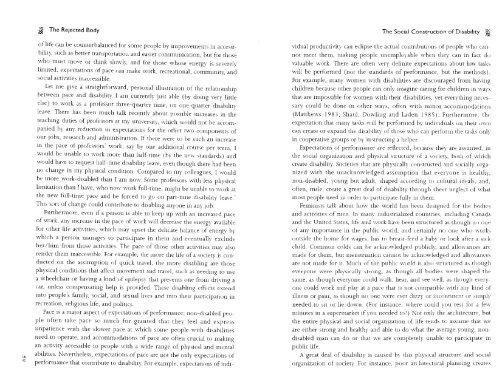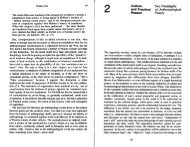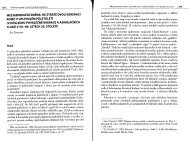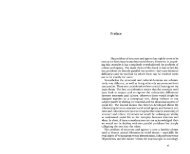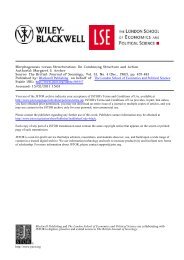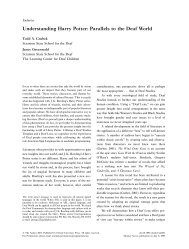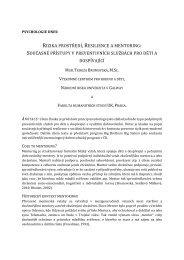The Social Construction of Disability - Moodle
The Social Construction of Disability - Moodle
The Social Construction of Disability - Moodle
You also want an ePaper? Increase the reach of your titles
YUMPU automatically turns print PDFs into web optimized ePapers that Google loves.
'Jl'-C~ <strong>The</strong> Rejected Body<strong>of</strong> life can be counterbalanced for some people by improvements in accessibility,such as better transportation and easier communication, but for thosewho must move or think slowly, and for those whose energy is severelylimited, expectations <strong>of</strong> pace can make work, recreational, community, andsocial acti vities inaccessible.Let me give a straightforward, personal illustration <strong>of</strong> the relationshipbetween pace and disability. I am currently just able (by doing very littleelse) to work as a pr<strong>of</strong>essor three-quarter time, on one-quarter disabilityleave. <strong>The</strong>re has been much talk recently about possible increases in theteaching duties <strong>of</strong> pr<strong>of</strong>essors at my university, which would not be accompaniedby any reduction in expectations for the other two components <strong>of</strong>our jobs, research and administration. If there were to be such an increasein the pace <strong>of</strong> pr<strong>of</strong>essors' work, say by one additional course per term, Iwould be unable to work more than half- time (hI' the new standards) andwould have to request half-time disability leave, even though there had beenno change in my physical condition. Compared to my colleagues, I wouldbe more work-disabled than I am now. Some pr<strong>of</strong>essors with less physicallimitation than I have, who now work full-time, might be unable to work atthe new full-time pace and be forced to go on part-time disabili ty leave.'This sort <strong>of</strong> change could contrihute to disabling anyone in any )0b.Furthermore, even if a person is able to keep up with an increased pace<strong>of</strong> work, any increase in the pace <strong>of</strong> work will decrease the energy availablefor other life activities, which may upset the delicate balance <strong>of</strong> energy bywhich a person manages to participate in them and eventually excludeher/him from those activities. <strong>The</strong> pace <strong>of</strong> those other activities may alsorender them inaccessible. For example, the more the life <strong>of</strong> a society is conductedon the assumption <strong>of</strong> quick travel, the more disabling are thosephysical conditions that affect movement and travel, such as needing to usea wheelchair or having a kind <strong>of</strong> epilepsy that prevents one from driving acar, unless compensating help is provided. <strong>The</strong>se disabling effects extendinto people's family, social, and sexual lives and into their participation inrecreation, religious life, and politics.Pace is a major aspect <strong>of</strong> expectations <strong>of</strong> performance; non-disabled people<strong>of</strong>ten take pace so much for granted that they feel and expressimpatience with the slower pace at which some people with disabilitiesneed to operate, and accommodations <strong>of</strong> pace are <strong>of</strong>ten crucial to makingan activity accessible to people with a wide range <strong>of</strong> physical and mentalabilities. Nevertheless, expectations <strong>of</strong> pace are not the only expectations <strong>of</strong>performance that contribute to disability. For example, expectations <strong>of</strong> indi-<strong>The</strong> <strong>Social</strong> <strong>Construction</strong> <strong>of</strong> <strong>Disability</strong> ~vidual productivity can eclipse the actual contributions <strong>of</strong> people who cannotmeet them, making people unemployable when they can in fact dovaluable work. <strong>The</strong>re are <strong>of</strong>ten very definite expectations about how taskswill be performed (not the standards <strong>of</strong> performance, but the methods).For example, lIlany women with disabilities are discouraged from haVingchildren because other people can only imagine caring for children in waysthat are impossible for women with their disabilities, yet everything necessarycould be done in other ways, <strong>of</strong>ten with minor accommodations(Matthews 1983; Shaul, Dowling and Laden 1985). Furthermore. theexpectation that many tasks will be performed by individuals on their owncan create or expand the disability <strong>of</strong> those who can perform the tasks onlyin cooperative groups or by instructing a helper.Expectations <strong>of</strong> performance are reflected, because they are assumed, inthe social organization and physical structure <strong>of</strong> a society, buth <strong>of</strong> whichcreate disability. Societies that are physically constructed and socially organizedwith the unacknowledged assumption that everyone is healthy,non-disabled, young but adult, shaped according to cultural Ideals, and,<strong>of</strong>ten, male, create a great deal <strong>of</strong> disability through sheer neglect <strong>of</strong> whatmost people need in order to participate fully in them.Feminists talk about how the world has been designed for the bodiesand activities <strong>of</strong> men. In many industrialized countries, including Canadaand the United States, life and work have been structured as though no one<strong>of</strong> any importance in the public world, aud certainly no one who worksoutside the home for \\-ages, has to breast-feed a baby or look after a sickchild. Common colds can be acknowledged pu blidy, and allowances aremade for them, but menstruation cannot be acknowledged and allowancesare not made for it. Much <strong>of</strong> the public world is also structured as thougheveryone were physically strong, as though all bodies were shaped thesame, as though everyone could walk, hear, and see well, as though everyonecould work and play at a pace that is not compatible with ,my kind <strong>of</strong>illness or pain, as though no one were ever dizzy or incontinent or Simplyneeded to sit or lie down. (For instance, where could you rest for a fewminutes in a supermarket if you needed to J) Not only the architecture, butthe entire physical and social organization <strong>of</strong> life tends to assume that weare either strong and healthy and able to do what the average young, nondisabledman can do or that we are completely unable to participate inpublic life.A great deal <strong>of</strong> disability is caused by this physical structure and socialorganization <strong>of</strong> society. For instance, poor architectural planning creates


